Research Paper on Fuzzy AHP Framework for Qualitative Risk Analysis
VerifiedAdded on 2023/06/05
|28
|8845
|204
Report
AI Summary
This report presents a framework for qualitative risk analysis in construction projects using the Fuzzy Analytic Hierarchy Process (AHP). It addresses the challenges in evaluating risks at an early stage, which often leads to project complexities and resource management issues. The report explores how Fuzzy AHP can be used to rank risks, assess their probability and impact using linguistic terms and fuzzy numbers, and improve decision-making in construction management. It reviews existing literature on Fuzzy AHP applications in risk assessment, discusses a proposed model for risk assessment, and highlights the advantages of using Fuzzy AHP to identify and manage project risks, ultimately aiming to improve project quality and reduce the likelihood of project failure due to unmanaged risks. Desklib provides access to this and other solved assignments for students.
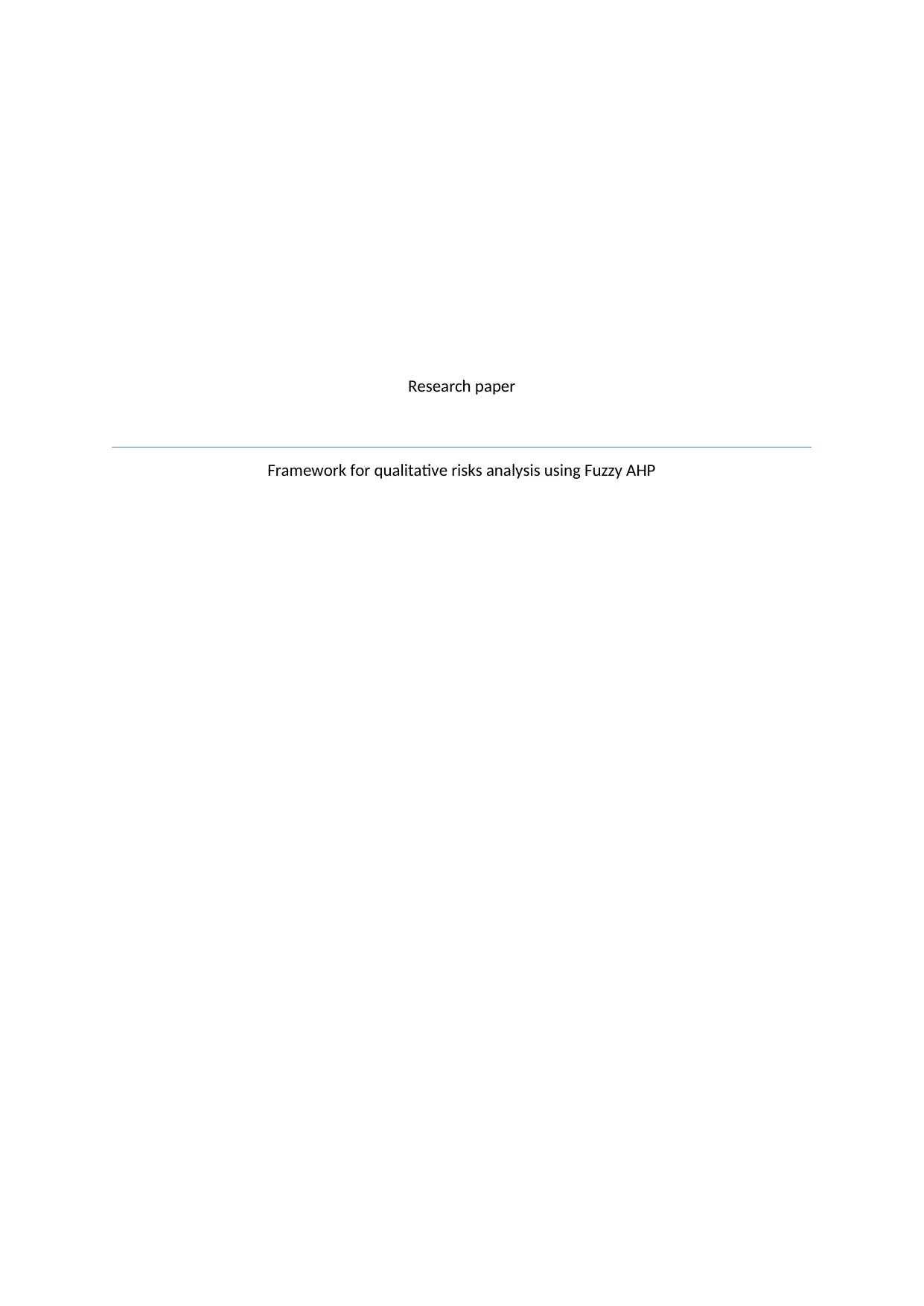
Research paper
Framework for qualitative risks analysis using Fuzzy AHP
Framework for qualitative risks analysis using Fuzzy AHP
Paraphrase This Document
Need a fresh take? Get an instant paraphrase of this document with our AI Paraphraser
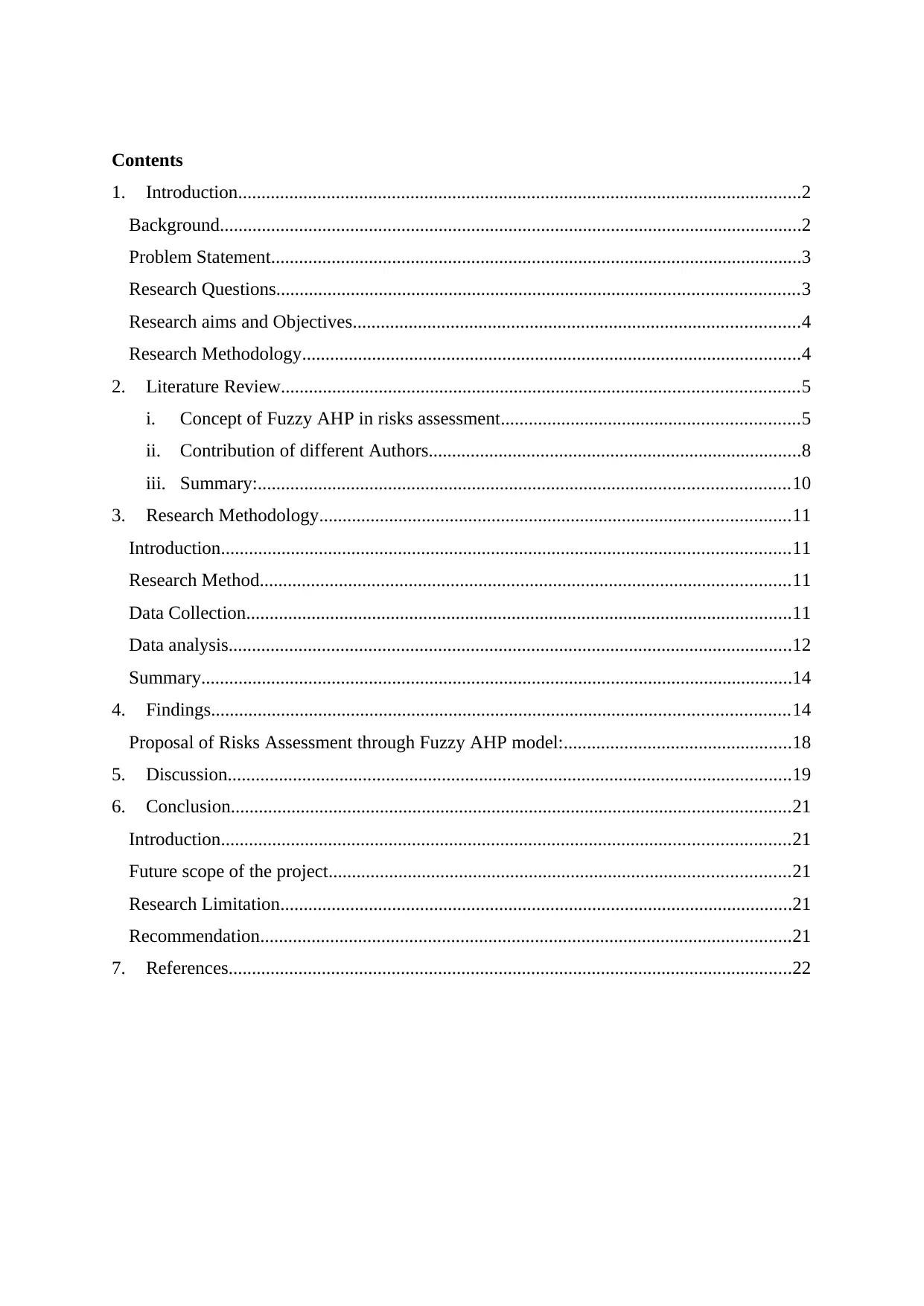
Contents
1. Introduction.........................................................................................................................2
Background.............................................................................................................................2
Problem Statement..................................................................................................................3
Research Questions................................................................................................................3
Research aims and Objectives................................................................................................4
Research Methodology...........................................................................................................4
2. Literature Review...............................................................................................................5
i. Concept of Fuzzy AHP in risks assessment................................................................5
ii. Contribution of different Authors................................................................................8
iii. Summary:..................................................................................................................10
3. Research Methodology.....................................................................................................11
Introduction..........................................................................................................................11
Research Method..................................................................................................................11
Data Collection.....................................................................................................................11
Data analysis.........................................................................................................................12
Summary...............................................................................................................................14
4. Findings............................................................................................................................14
Proposal of Risks Assessment through Fuzzy AHP model:.................................................18
5. Discussion.........................................................................................................................19
6. Conclusion........................................................................................................................21
Introduction..........................................................................................................................21
Future scope of the project...................................................................................................21
Research Limitation..............................................................................................................21
Recommendation..................................................................................................................21
7. References.........................................................................................................................22
1. Introduction.........................................................................................................................2
Background.............................................................................................................................2
Problem Statement..................................................................................................................3
Research Questions................................................................................................................3
Research aims and Objectives................................................................................................4
Research Methodology...........................................................................................................4
2. Literature Review...............................................................................................................5
i. Concept of Fuzzy AHP in risks assessment................................................................5
ii. Contribution of different Authors................................................................................8
iii. Summary:..................................................................................................................10
3. Research Methodology.....................................................................................................11
Introduction..........................................................................................................................11
Research Method..................................................................................................................11
Data Collection.....................................................................................................................11
Data analysis.........................................................................................................................12
Summary...............................................................................................................................14
4. Findings............................................................................................................................14
Proposal of Risks Assessment through Fuzzy AHP model:.................................................18
5. Discussion.........................................................................................................................19
6. Conclusion........................................................................................................................21
Introduction..........................................................................................................................21
Future scope of the project...................................................................................................21
Research Limitation..............................................................................................................21
Recommendation..................................................................................................................21
7. References.........................................................................................................................22
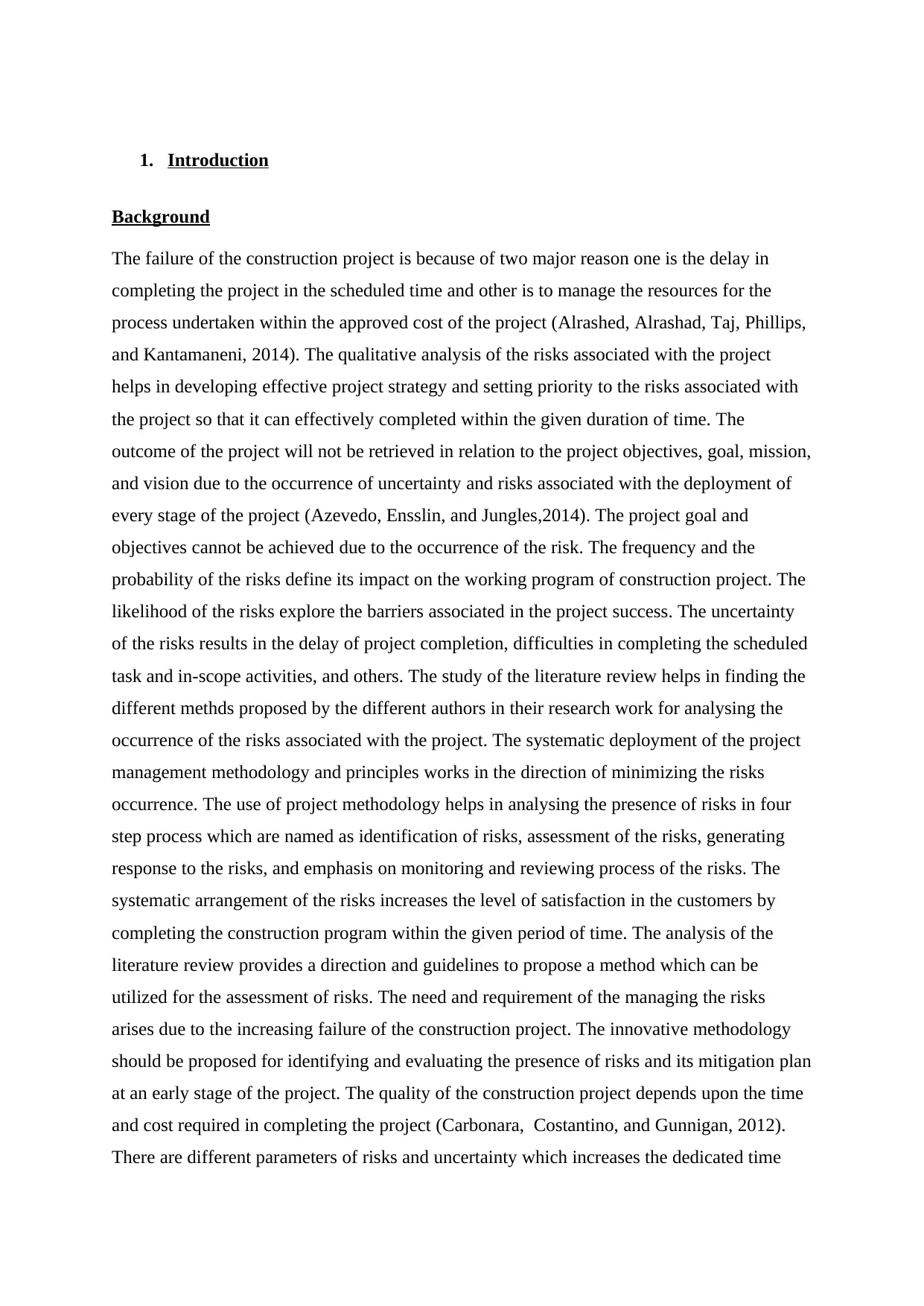
1. Introduction
Background
The failure of the construction project is because of two major reason one is the delay in
completing the project in the scheduled time and other is to manage the resources for the
process undertaken within the approved cost of the project (Alrashed, Alrashad, Taj, Phillips,
and Kantamaneni, 2014). The qualitative analysis of the risks associated with the project
helps in developing effective project strategy and setting priority to the risks associated with
the project so that it can effectively completed within the given duration of time. The
outcome of the project will not be retrieved in relation to the project objectives, goal, mission,
and vision due to the occurrence of uncertainty and risks associated with the deployment of
every stage of the project (Azevedo, Ensslin, and Jungles,2014). The project goal and
objectives cannot be achieved due to the occurrence of the risk. The frequency and the
probability of the risks define its impact on the working program of construction project. The
likelihood of the risks explore the barriers associated in the project success. The uncertainty
of the risks results in the delay of project completion, difficulties in completing the scheduled
task and in-scope activities, and others. The study of the literature review helps in finding the
different methds proposed by the different authors in their research work for analysing the
occurrence of the risks associated with the project. The systematic deployment of the project
management methodology and principles works in the direction of minimizing the risks
occurrence. The use of project methodology helps in analysing the presence of risks in four
step process which are named as identification of risks, assessment of the risks, generating
response to the risks, and emphasis on monitoring and reviewing process of the risks. The
systematic arrangement of the risks increases the level of satisfaction in the customers by
completing the construction program within the given period of time. The analysis of the
literature review provides a direction and guidelines to propose a method which can be
utilized for the assessment of risks. The need and requirement of the managing the risks
arises due to the increasing failure of the construction project. The innovative methodology
should be proposed for identifying and evaluating the presence of risks and its mitigation plan
at an early stage of the project. The quality of the construction project depends upon the time
and cost required in completing the project (Carbonara, Costantino, and Gunnigan, 2012).
There are different parameters of risks and uncertainty which increases the dedicated time
Background
The failure of the construction project is because of two major reason one is the delay in
completing the project in the scheduled time and other is to manage the resources for the
process undertaken within the approved cost of the project (Alrashed, Alrashad, Taj, Phillips,
and Kantamaneni, 2014). The qualitative analysis of the risks associated with the project
helps in developing effective project strategy and setting priority to the risks associated with
the project so that it can effectively completed within the given duration of time. The
outcome of the project will not be retrieved in relation to the project objectives, goal, mission,
and vision due to the occurrence of uncertainty and risks associated with the deployment of
every stage of the project (Azevedo, Ensslin, and Jungles,2014). The project goal and
objectives cannot be achieved due to the occurrence of the risk. The frequency and the
probability of the risks define its impact on the working program of construction project. The
likelihood of the risks explore the barriers associated in the project success. The uncertainty
of the risks results in the delay of project completion, difficulties in completing the scheduled
task and in-scope activities, and others. The study of the literature review helps in finding the
different methds proposed by the different authors in their research work for analysing the
occurrence of the risks associated with the project. The systematic deployment of the project
management methodology and principles works in the direction of minimizing the risks
occurrence. The use of project methodology helps in analysing the presence of risks in four
step process which are named as identification of risks, assessment of the risks, generating
response to the risks, and emphasis on monitoring and reviewing process of the risks. The
systematic arrangement of the risks increases the level of satisfaction in the customers by
completing the construction program within the given period of time. The analysis of the
literature review provides a direction and guidelines to propose a method which can be
utilized for the assessment of risks. The need and requirement of the managing the risks
arises due to the increasing failure of the construction project. The innovative methodology
should be proposed for identifying and evaluating the presence of risks and its mitigation plan
at an early stage of the project. The quality of the construction project depends upon the time
and cost required in completing the project (Carbonara, Costantino, and Gunnigan, 2012).
There are different parameters of risks and uncertainty which increases the dedicated time
⊘ This is a preview!⊘
Do you want full access?
Subscribe today to unlock all pages.

Trusted by 1+ million students worldwide
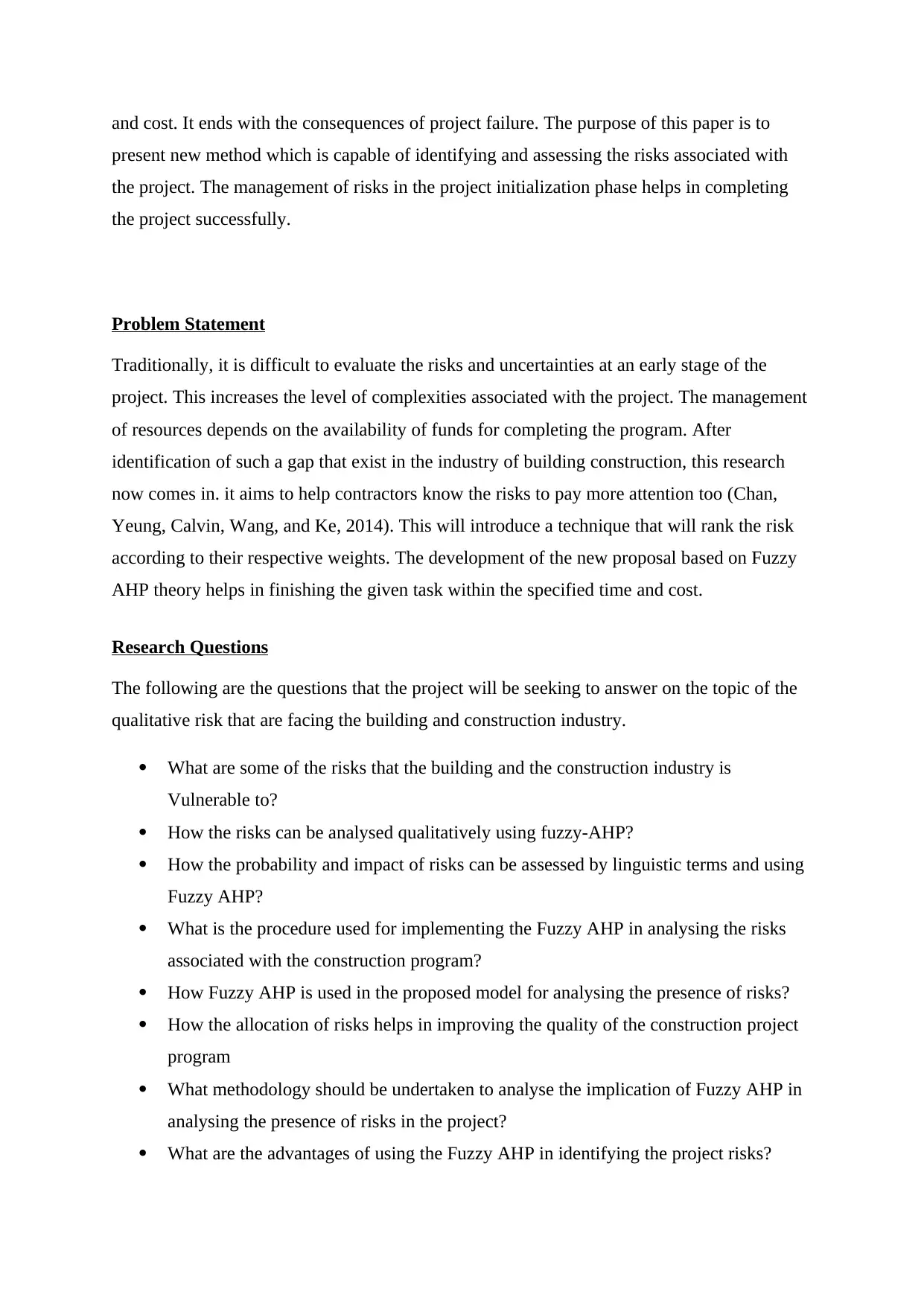
and cost. It ends with the consequences of project failure. The purpose of this paper is to
present new method which is capable of identifying and assessing the risks associated with
the project. The management of risks in the project initialization phase helps in completing
the project successfully.
Problem Statement
Traditionally, it is difficult to evaluate the risks and uncertainties at an early stage of the
project. This increases the level of complexities associated with the project. The management
of resources depends on the availability of funds for completing the program. After
identification of such a gap that exist in the industry of building construction, this research
now comes in. it aims to help contractors know the risks to pay more attention too (Chan,
Yeung, Calvin, Wang, and Ke, 2014). This will introduce a technique that will rank the risk
according to their respective weights. The development of the new proposal based on Fuzzy
AHP theory helps in finishing the given task within the specified time and cost.
Research Questions
The following are the questions that the project will be seeking to answer on the topic of the
qualitative risk that are facing the building and construction industry.
What are some of the risks that the building and the construction industry is
Vulnerable to?
How the risks can be analysed qualitatively using fuzzy-AHP?
How the probability and impact of risks can be assessed by linguistic terms and using
Fuzzy AHP?
What is the procedure used for implementing the Fuzzy AHP in analysing the risks
associated with the construction program?
How Fuzzy AHP is used in the proposed model for analysing the presence of risks?
How the allocation of risks helps in improving the quality of the construction project
program
What methodology should be undertaken to analyse the implication of Fuzzy AHP in
analysing the presence of risks in the project?
What are the advantages of using the Fuzzy AHP in identifying the project risks?
present new method which is capable of identifying and assessing the risks associated with
the project. The management of risks in the project initialization phase helps in completing
the project successfully.
Problem Statement
Traditionally, it is difficult to evaluate the risks and uncertainties at an early stage of the
project. This increases the level of complexities associated with the project. The management
of resources depends on the availability of funds for completing the program. After
identification of such a gap that exist in the industry of building construction, this research
now comes in. it aims to help contractors know the risks to pay more attention too (Chan,
Yeung, Calvin, Wang, and Ke, 2014). This will introduce a technique that will rank the risk
according to their respective weights. The development of the new proposal based on Fuzzy
AHP theory helps in finishing the given task within the specified time and cost.
Research Questions
The following are the questions that the project will be seeking to answer on the topic of the
qualitative risk that are facing the building and construction industry.
What are some of the risks that the building and the construction industry is
Vulnerable to?
How the risks can be analysed qualitatively using fuzzy-AHP?
How the probability and impact of risks can be assessed by linguistic terms and using
Fuzzy AHP?
What is the procedure used for implementing the Fuzzy AHP in analysing the risks
associated with the construction program?
How Fuzzy AHP is used in the proposed model for analysing the presence of risks?
How the allocation of risks helps in improving the quality of the construction project
program
What methodology should be undertaken to analyse the implication of Fuzzy AHP in
analysing the presence of risks in the project?
What are the advantages of using the Fuzzy AHP in identifying the project risks?
Paraphrase This Document
Need a fresh take? Get an instant paraphrase of this document with our AI Paraphraser
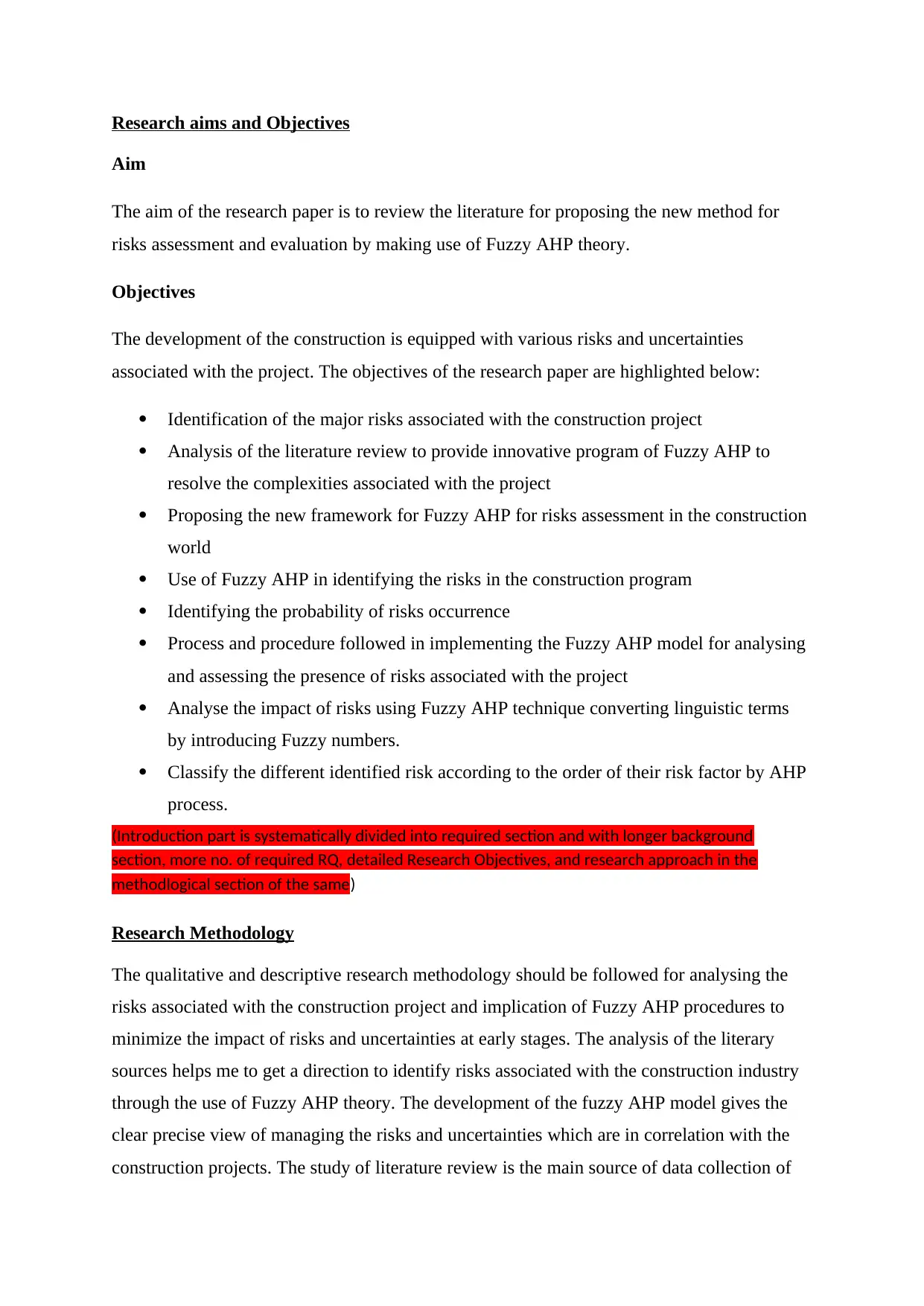
Research aims and Objectives
Aim
The aim of the research paper is to review the literature for proposing the new method for
risks assessment and evaluation by making use of Fuzzy AHP theory.
Objectives
The development of the construction is equipped with various risks and uncertainties
associated with the project. The objectives of the research paper are highlighted below:
Identification of the major risks associated with the construction project
Analysis of the literature review to provide innovative program of Fuzzy AHP to
resolve the complexities associated with the project
Proposing the new framework for Fuzzy AHP for risks assessment in the construction
world
Use of Fuzzy AHP in identifying the risks in the construction program
Identifying the probability of risks occurrence
Process and procedure followed in implementing the Fuzzy AHP model for analysing
and assessing the presence of risks associated with the project
Analyse the impact of risks using Fuzzy AHP technique converting linguistic terms
by introducing Fuzzy numbers.
Classify the different identified risk according to the order of their risk factor by AHP
process.
(Introduction part is systematically divided into required section and with longer background
section, more no. of required RQ, detailed Research Objectives, and research approach in the
methodlogical section of the same)
Research Methodology
The qualitative and descriptive research methodology should be followed for analysing the
risks associated with the construction project and implication of Fuzzy AHP procedures to
minimize the impact of risks and uncertainties at early stages. The analysis of the literary
sources helps me to get a direction to identify risks associated with the construction industry
through the use of Fuzzy AHP theory. The development of the fuzzy AHP model gives the
clear precise view of managing the risks and uncertainties which are in correlation with the
construction projects. The study of literature review is the main source of data collection of
Aim
The aim of the research paper is to review the literature for proposing the new method for
risks assessment and evaluation by making use of Fuzzy AHP theory.
Objectives
The development of the construction is equipped with various risks and uncertainties
associated with the project. The objectives of the research paper are highlighted below:
Identification of the major risks associated with the construction project
Analysis of the literature review to provide innovative program of Fuzzy AHP to
resolve the complexities associated with the project
Proposing the new framework for Fuzzy AHP for risks assessment in the construction
world
Use of Fuzzy AHP in identifying the risks in the construction program
Identifying the probability of risks occurrence
Process and procedure followed in implementing the Fuzzy AHP model for analysing
and assessing the presence of risks associated with the project
Analyse the impact of risks using Fuzzy AHP technique converting linguistic terms
by introducing Fuzzy numbers.
Classify the different identified risk according to the order of their risk factor by AHP
process.
(Introduction part is systematically divided into required section and with longer background
section, more no. of required RQ, detailed Research Objectives, and research approach in the
methodlogical section of the same)
Research Methodology
The qualitative and descriptive research methodology should be followed for analysing the
risks associated with the construction project and implication of Fuzzy AHP procedures to
minimize the impact of risks and uncertainties at early stages. The analysis of the literary
sources helps me to get a direction to identify risks associated with the construction industry
through the use of Fuzzy AHP theory. The development of the fuzzy AHP model gives the
clear precise view of managing the risks and uncertainties which are in correlation with the
construction projects. The study of literature review is the main source of data collection of
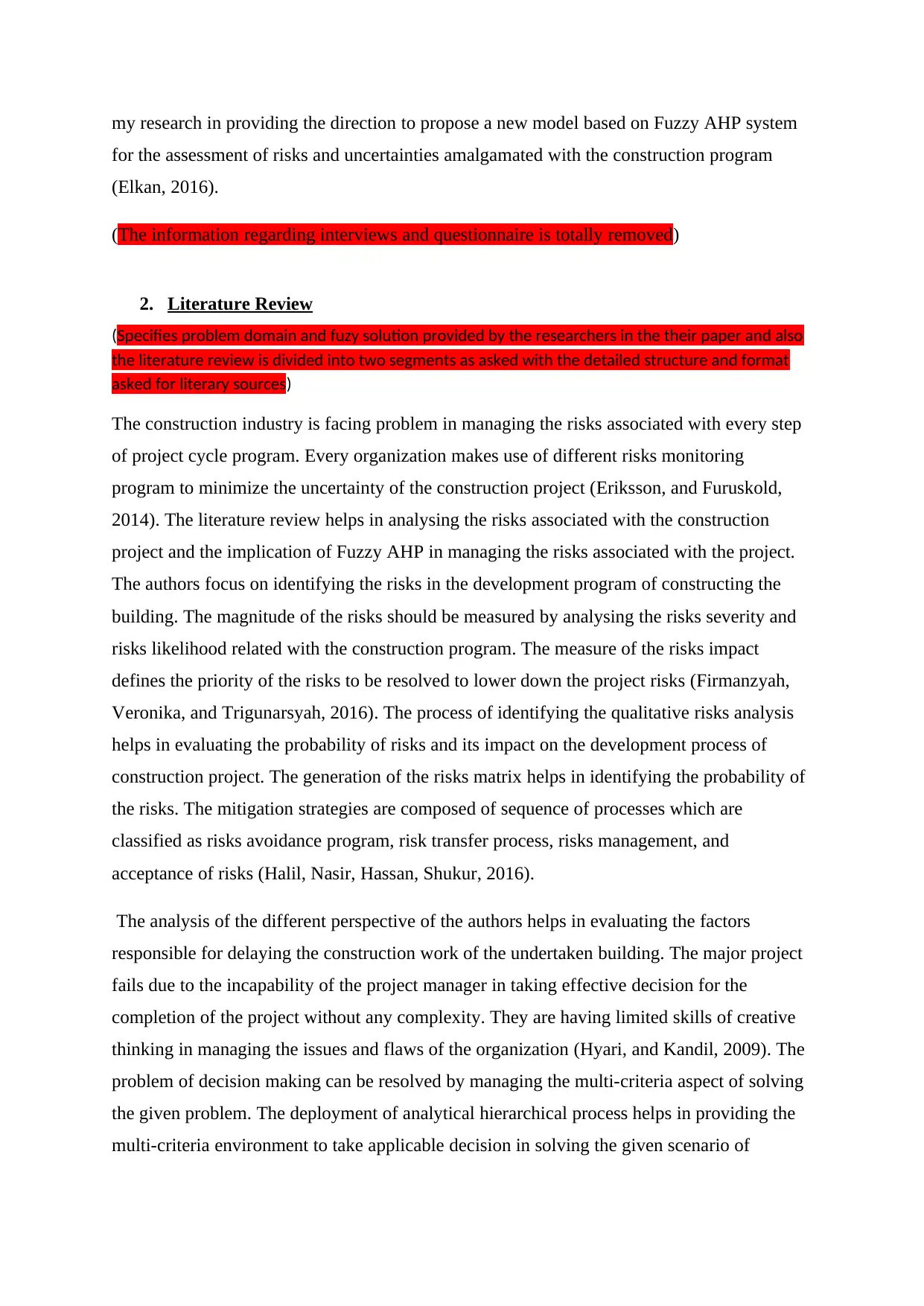
my research in providing the direction to propose a new model based on Fuzzy AHP system
for the assessment of risks and uncertainties amalgamated with the construction program
(Elkan, 2016).
(The information regarding interviews and questionnaire is totally removed)
2. Literature Review
(Specifies problem domain and fuzy solution provided by the researchers in the their paper and also
the literature review is divided into two segments as asked with the detailed structure and format
asked for literary sources)
The construction industry is facing problem in managing the risks associated with every step
of project cycle program. Every organization makes use of different risks monitoring
program to minimize the uncertainty of the construction project (Eriksson, and Furuskold,
2014). The literature review helps in analysing the risks associated with the construction
project and the implication of Fuzzy AHP in managing the risks associated with the project.
The authors focus on identifying the risks in the development program of constructing the
building. The magnitude of the risks should be measured by analysing the risks severity and
risks likelihood related with the construction program. The measure of the risks impact
defines the priority of the risks to be resolved to lower down the project risks (Firmanzyah,
Veronika, and Trigunarsyah, 2016). The process of identifying the qualitative risks analysis
helps in evaluating the probability of risks and its impact on the development process of
construction project. The generation of the risks matrix helps in identifying the probability of
the risks. The mitigation strategies are composed of sequence of processes which are
classified as risks avoidance program, risk transfer process, risks management, and
acceptance of risks (Halil, Nasir, Hassan, Shukur, 2016).
The analysis of the different perspective of the authors helps in evaluating the factors
responsible for delaying the construction work of the undertaken building. The major project
fails due to the incapability of the project manager in taking effective decision for the
completion of the project without any complexity. They are having limited skills of creative
thinking in managing the issues and flaws of the organization (Hyari, and Kandil, 2009). The
problem of decision making can be resolved by managing the multi-criteria aspect of solving
the given problem. The deployment of analytical hierarchical process helps in providing the
multi-criteria environment to take applicable decision in solving the given scenario of
for the assessment of risks and uncertainties amalgamated with the construction program
(Elkan, 2016).
(The information regarding interviews and questionnaire is totally removed)
2. Literature Review
(Specifies problem domain and fuzy solution provided by the researchers in the their paper and also
the literature review is divided into two segments as asked with the detailed structure and format
asked for literary sources)
The construction industry is facing problem in managing the risks associated with every step
of project cycle program. Every organization makes use of different risks monitoring
program to minimize the uncertainty of the construction project (Eriksson, and Furuskold,
2014). The literature review helps in analysing the risks associated with the construction
project and the implication of Fuzzy AHP in managing the risks associated with the project.
The authors focus on identifying the risks in the development program of constructing the
building. The magnitude of the risks should be measured by analysing the risks severity and
risks likelihood related with the construction program. The measure of the risks impact
defines the priority of the risks to be resolved to lower down the project risks (Firmanzyah,
Veronika, and Trigunarsyah, 2016). The process of identifying the qualitative risks analysis
helps in evaluating the probability of risks and its impact on the development process of
construction project. The generation of the risks matrix helps in identifying the probability of
the risks. The mitigation strategies are composed of sequence of processes which are
classified as risks avoidance program, risk transfer process, risks management, and
acceptance of risks (Halil, Nasir, Hassan, Shukur, 2016).
The analysis of the different perspective of the authors helps in evaluating the factors
responsible for delaying the construction work of the undertaken building. The major project
fails due to the incapability of the project manager in taking effective decision for the
completion of the project without any complexity. They are having limited skills of creative
thinking in managing the issues and flaws of the organization (Hyari, and Kandil, 2009). The
problem of decision making can be resolved by managing the multi-criteria aspect of solving
the given problem. The deployment of analytical hierarchical process helps in providing the
multi-criteria environment to take applicable decision in solving the given scenario of
⊘ This is a preview!⊘
Do you want full access?
Subscribe today to unlock all pages.

Trusted by 1+ million students worldwide
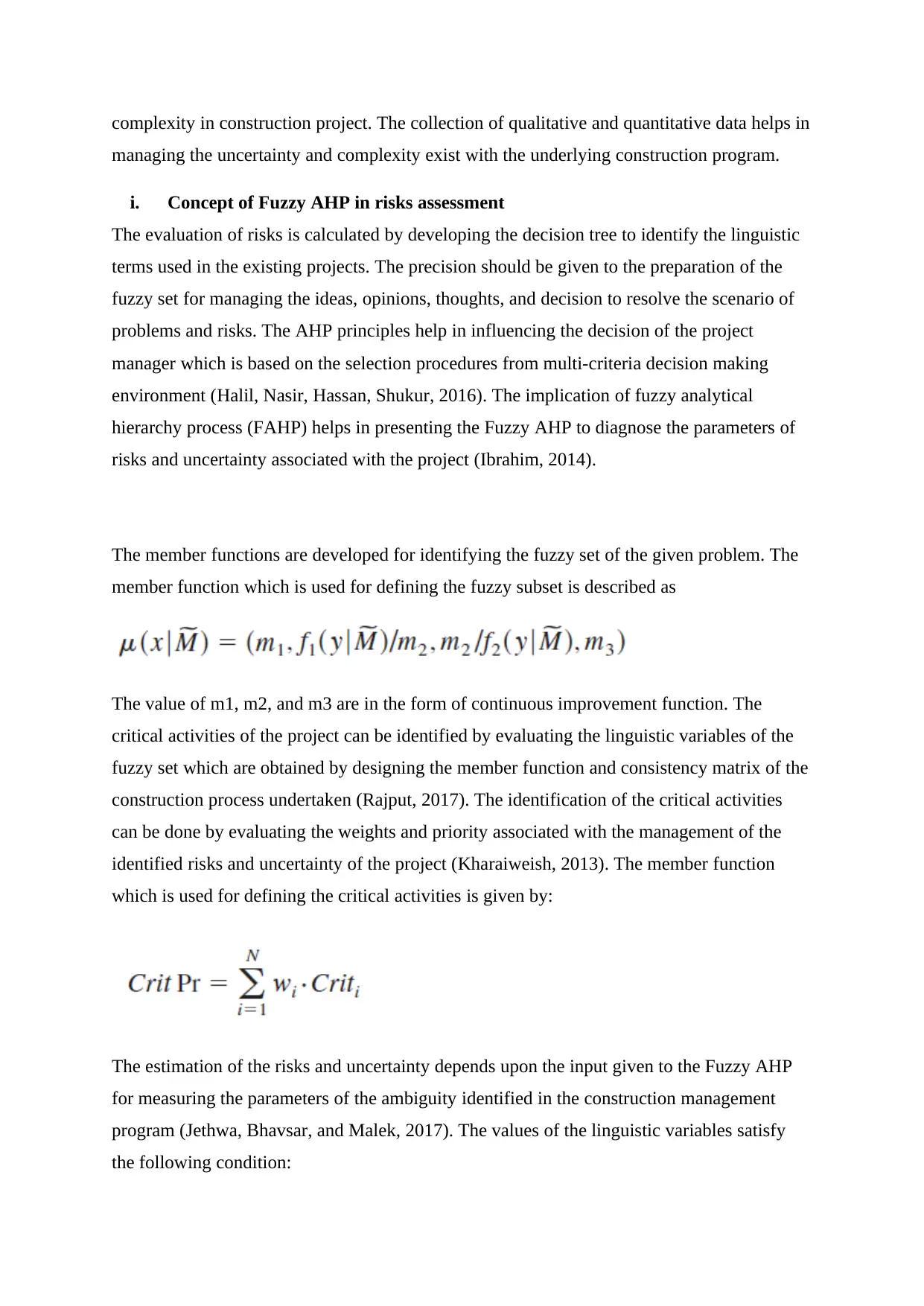
complexity in construction project. The collection of qualitative and quantitative data helps in
managing the uncertainty and complexity exist with the underlying construction program.
i. Concept of Fuzzy AHP in risks assessment
The evaluation of risks is calculated by developing the decision tree to identify the linguistic
terms used in the existing projects. The precision should be given to the preparation of the
fuzzy set for managing the ideas, opinions, thoughts, and decision to resolve the scenario of
problems and risks. The AHP principles help in influencing the decision of the project
manager which is based on the selection procedures from multi-criteria decision making
environment (Halil, Nasir, Hassan, Shukur, 2016). The implication of fuzzy analytical
hierarchy process (FAHP) helps in presenting the Fuzzy AHP to diagnose the parameters of
risks and uncertainty associated with the project (Ibrahim, 2014).
The member functions are developed for identifying the fuzzy set of the given problem. The
member function which is used for defining the fuzzy subset is described as
The value of m1, m2, and m3 are in the form of continuous improvement function. The
critical activities of the project can be identified by evaluating the linguistic variables of the
fuzzy set which are obtained by designing the member function and consistency matrix of the
construction process undertaken (Rajput, 2017). The identification of the critical activities
can be done by evaluating the weights and priority associated with the management of the
identified risks and uncertainty of the project (Kharaiweish, 2013). The member function
which is used for defining the critical activities is given by:
The estimation of the risks and uncertainty depends upon the input given to the Fuzzy AHP
for measuring the parameters of the ambiguity identified in the construction management
program (Jethwa, Bhavsar, and Malek, 2017). The values of the linguistic variables satisfy
the following condition:
managing the uncertainty and complexity exist with the underlying construction program.
i. Concept of Fuzzy AHP in risks assessment
The evaluation of risks is calculated by developing the decision tree to identify the linguistic
terms used in the existing projects. The precision should be given to the preparation of the
fuzzy set for managing the ideas, opinions, thoughts, and decision to resolve the scenario of
problems and risks. The AHP principles help in influencing the decision of the project
manager which is based on the selection procedures from multi-criteria decision making
environment (Halil, Nasir, Hassan, Shukur, 2016). The implication of fuzzy analytical
hierarchy process (FAHP) helps in presenting the Fuzzy AHP to diagnose the parameters of
risks and uncertainty associated with the project (Ibrahim, 2014).
The member functions are developed for identifying the fuzzy set of the given problem. The
member function which is used for defining the fuzzy subset is described as
The value of m1, m2, and m3 are in the form of continuous improvement function. The
critical activities of the project can be identified by evaluating the linguistic variables of the
fuzzy set which are obtained by designing the member function and consistency matrix of the
construction process undertaken (Rajput, 2017). The identification of the critical activities
can be done by evaluating the weights and priority associated with the management of the
identified risks and uncertainty of the project (Kharaiweish, 2013). The member function
which is used for defining the critical activities is given by:
The estimation of the risks and uncertainty depends upon the input given to the Fuzzy AHP
for measuring the parameters of the ambiguity identified in the construction management
program (Jethwa, Bhavsar, and Malek, 2017). The values of the linguistic variables satisfy
the following condition:
Paraphrase This Document
Need a fresh take? Get an instant paraphrase of this document with our AI Paraphraser
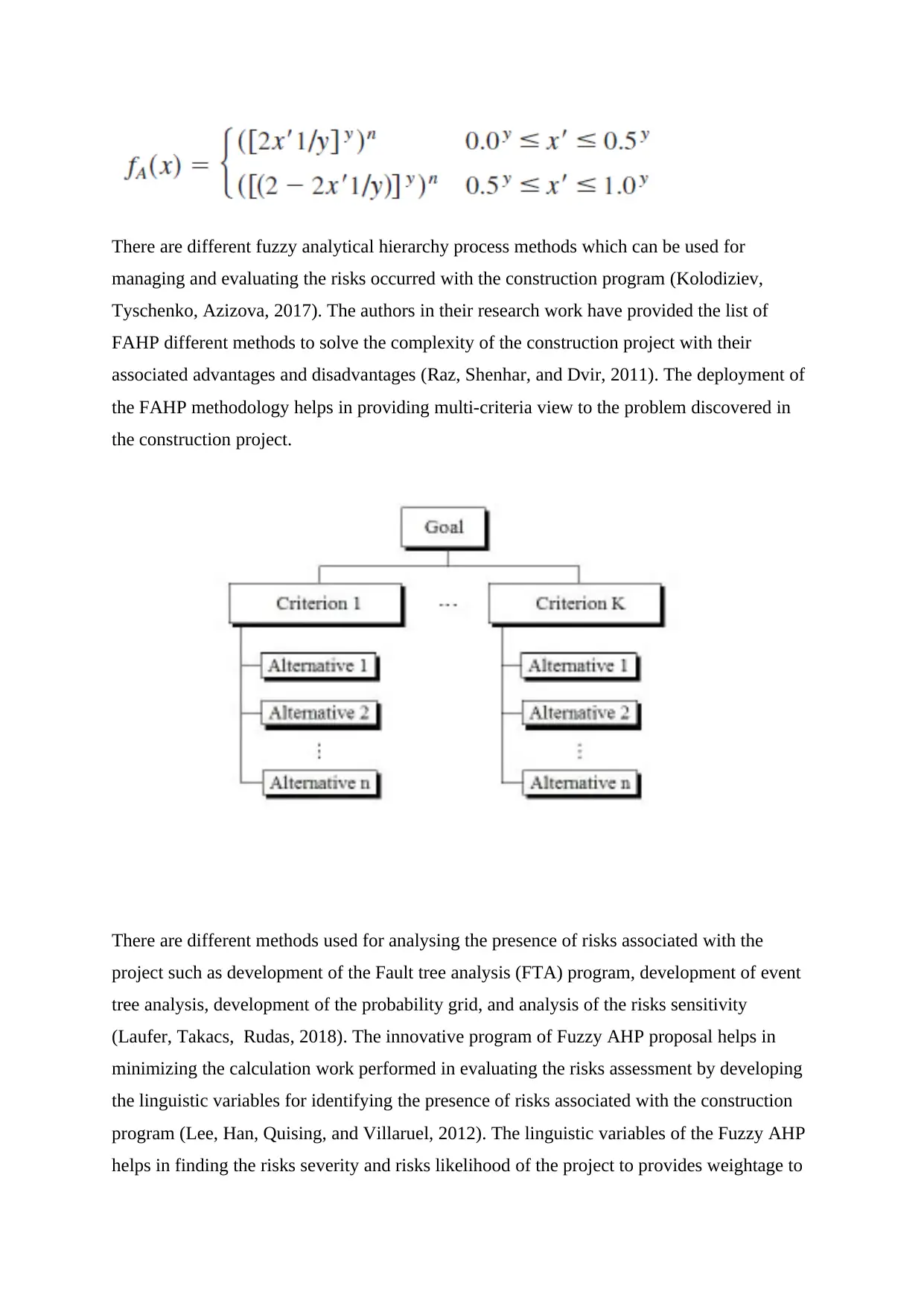
There are different fuzzy analytical hierarchy process methods which can be used for
managing and evaluating the risks occurred with the construction program (Kolodiziev,
Tyschenko, Azizova, 2017). The authors in their research work have provided the list of
FAHP different methods to solve the complexity of the construction project with their
associated advantages and disadvantages (Raz, Shenhar, and Dvir, 2011). The deployment of
the FAHP methodology helps in providing multi-criteria view to the problem discovered in
the construction project.
There are different methods used for analysing the presence of risks associated with the
project such as development of the Fault tree analysis (FTA) program, development of event
tree analysis, development of the probability grid, and analysis of the risks sensitivity
(Laufer, Takacs, Rudas, 2018). The innovative program of Fuzzy AHP proposal helps in
minimizing the calculation work performed in evaluating the risks assessment by developing
the linguistic variables for identifying the presence of risks associated with the construction
program (Lee, Han, Quising, and Villaruel, 2012). The linguistic variables of the Fuzzy AHP
helps in finding the risks severity and risks likelihood of the project to provides weightage to
managing and evaluating the risks occurred with the construction program (Kolodiziev,
Tyschenko, Azizova, 2017). The authors in their research work have provided the list of
FAHP different methods to solve the complexity of the construction project with their
associated advantages and disadvantages (Raz, Shenhar, and Dvir, 2011). The deployment of
the FAHP methodology helps in providing multi-criteria view to the problem discovered in
the construction project.
There are different methods used for analysing the presence of risks associated with the
project such as development of the Fault tree analysis (FTA) program, development of event
tree analysis, development of the probability grid, and analysis of the risks sensitivity
(Laufer, Takacs, Rudas, 2018). The innovative program of Fuzzy AHP proposal helps in
minimizing the calculation work performed in evaluating the risks assessment by developing
the linguistic variables for identifying the presence of risks associated with the construction
program (Lee, Han, Quising, and Villaruel, 2012). The linguistic variables of the Fuzzy AHP
helps in finding the risks severity and risks likelihood of the project to provides weightage to
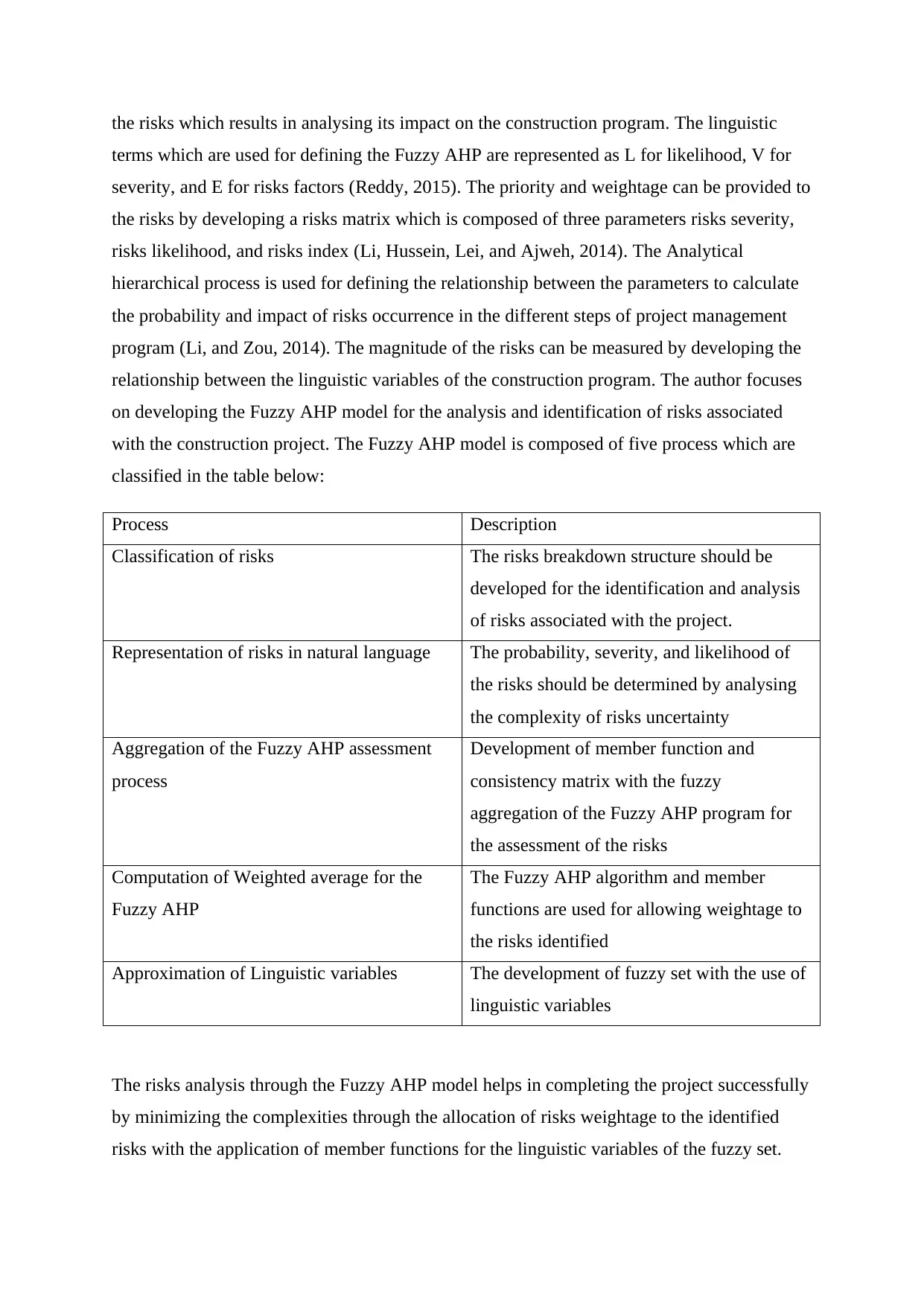
the risks which results in analysing its impact on the construction program. The linguistic
terms which are used for defining the Fuzzy AHP are represented as L for likelihood, V for
severity, and E for risks factors (Reddy, 2015). The priority and weightage can be provided to
the risks by developing a risks matrix which is composed of three parameters risks severity,
risks likelihood, and risks index (Li, Hussein, Lei, and Ajweh, 2014). The Analytical
hierarchical process is used for defining the relationship between the parameters to calculate
the probability and impact of risks occurrence in the different steps of project management
program (Li, and Zou, 2014). The magnitude of the risks can be measured by developing the
relationship between the linguistic variables of the construction program. The author focuses
on developing the Fuzzy AHP model for the analysis and identification of risks associated
with the construction project. The Fuzzy AHP model is composed of five process which are
classified in the table below:
Process Description
Classification of risks The risks breakdown structure should be
developed for the identification and analysis
of risks associated with the project.
Representation of risks in natural language The probability, severity, and likelihood of
the risks should be determined by analysing
the complexity of risks uncertainty
Aggregation of the Fuzzy AHP assessment
process
Development of member function and
consistency matrix with the fuzzy
aggregation of the Fuzzy AHP program for
the assessment of the risks
Computation of Weighted average for the
Fuzzy AHP
The Fuzzy AHP algorithm and member
functions are used for allowing weightage to
the risks identified
Approximation of Linguistic variables The development of fuzzy set with the use of
linguistic variables
The risks analysis through the Fuzzy AHP model helps in completing the project successfully
by minimizing the complexities through the allocation of risks weightage to the identified
risks with the application of member functions for the linguistic variables of the fuzzy set.
terms which are used for defining the Fuzzy AHP are represented as L for likelihood, V for
severity, and E for risks factors (Reddy, 2015). The priority and weightage can be provided to
the risks by developing a risks matrix which is composed of three parameters risks severity,
risks likelihood, and risks index (Li, Hussein, Lei, and Ajweh, 2014). The Analytical
hierarchical process is used for defining the relationship between the parameters to calculate
the probability and impact of risks occurrence in the different steps of project management
program (Li, and Zou, 2014). The magnitude of the risks can be measured by developing the
relationship between the linguistic variables of the construction program. The author focuses
on developing the Fuzzy AHP model for the analysis and identification of risks associated
with the construction project. The Fuzzy AHP model is composed of five process which are
classified in the table below:
Process Description
Classification of risks The risks breakdown structure should be
developed for the identification and analysis
of risks associated with the project.
Representation of risks in natural language The probability, severity, and likelihood of
the risks should be determined by analysing
the complexity of risks uncertainty
Aggregation of the Fuzzy AHP assessment
process
Development of member function and
consistency matrix with the fuzzy
aggregation of the Fuzzy AHP program for
the assessment of the risks
Computation of Weighted average for the
Fuzzy AHP
The Fuzzy AHP algorithm and member
functions are used for allowing weightage to
the risks identified
Approximation of Linguistic variables The development of fuzzy set with the use of
linguistic variables
The risks analysis through the Fuzzy AHP model helps in completing the project successfully
by minimizing the complexities through the allocation of risks weightage to the identified
risks with the application of member functions for the linguistic variables of the fuzzy set.
⊘ This is a preview!⊘
Do you want full access?
Subscribe today to unlock all pages.

Trusted by 1+ million students worldwide
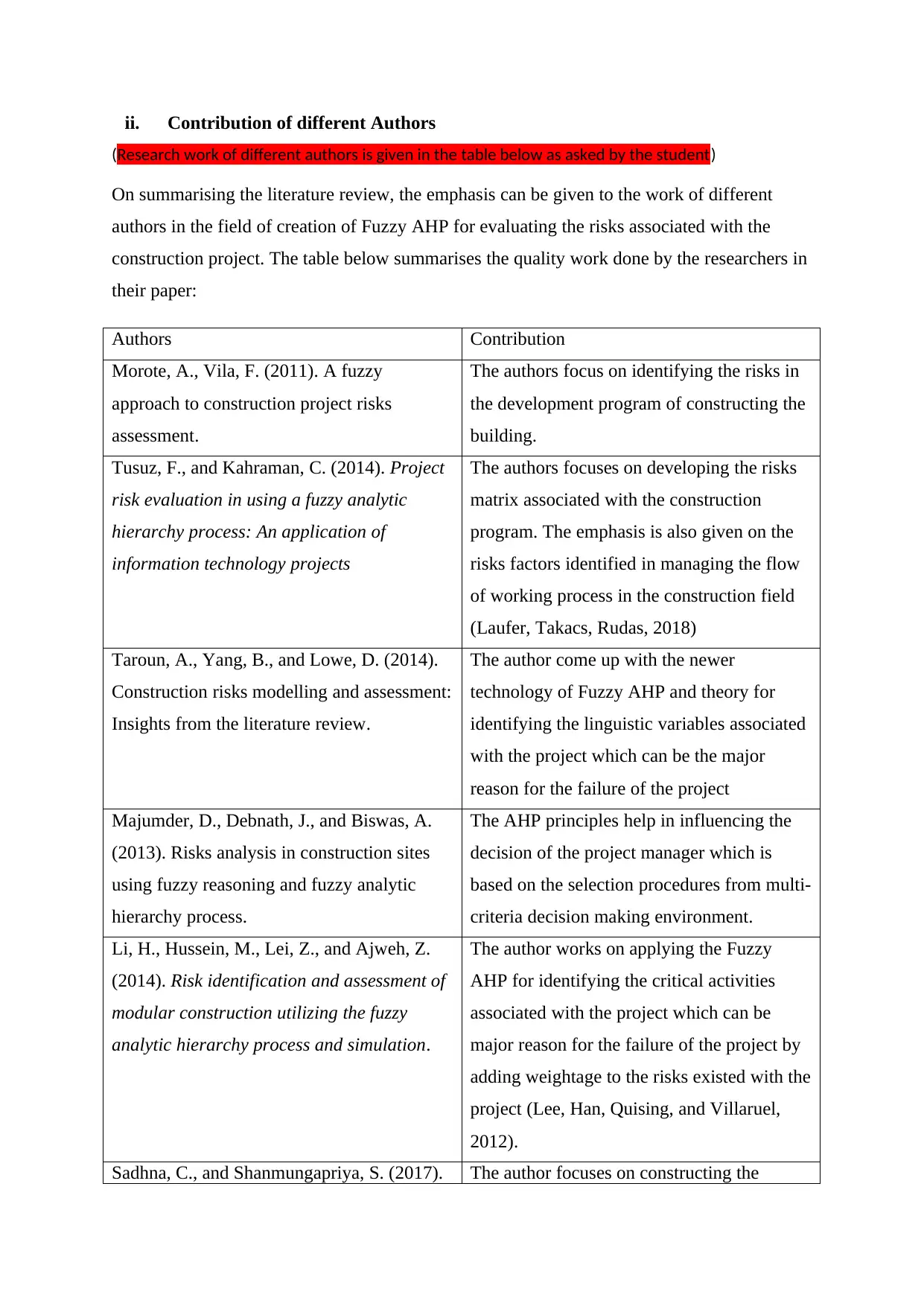
ii. Contribution of different Authors
(Research work of different authors is given in the table below as asked by the student)
On summarising the literature review, the emphasis can be given to the work of different
authors in the field of creation of Fuzzy AHP for evaluating the risks associated with the
construction project. The table below summarises the quality work done by the researchers in
their paper:
Authors Contribution
Morote, A., Vila, F. (2011). A fuzzy
approach to construction project risks
assessment.
The authors focus on identifying the risks in
the development program of constructing the
building.
Tusuz, F., and Kahraman, C. (2014). Project
risk evaluation in using a fuzzy analytic
hierarchy process: An application of
information technology projects
The authors focuses on developing the risks
matrix associated with the construction
program. The emphasis is also given on the
risks factors identified in managing the flow
of working process in the construction field
(Laufer, Takacs, Rudas, 2018)
Taroun, A., Yang, B., and Lowe, D. (2014).
Construction risks modelling and assessment:
Insights from the literature review.
The author come up with the newer
technology of Fuzzy AHP and theory for
identifying the linguistic variables associated
with the project which can be the major
reason for the failure of the project
Majumder, D., Debnath, J., and Biswas, A.
(2013). Risks analysis in construction sites
using fuzzy reasoning and fuzzy analytic
hierarchy process.
The AHP principles help in influencing the
decision of the project manager which is
based on the selection procedures from multi-
criteria decision making environment.
Li, H., Hussein, M., Lei, Z., and Ajweh, Z.
(2014). Risk identification and assessment of
modular construction utilizing the fuzzy
analytic hierarchy process and simulation.
The author works on applying the Fuzzy
AHP for identifying the critical activities
associated with the project which can be
major reason for the failure of the project by
adding weightage to the risks existed with the
project (Lee, Han, Quising, and Villaruel,
2012).
Sadhna, C., and Shanmungapriya, S. (2017). The author focuses on constructing the
(Research work of different authors is given in the table below as asked by the student)
On summarising the literature review, the emphasis can be given to the work of different
authors in the field of creation of Fuzzy AHP for evaluating the risks associated with the
construction project. The table below summarises the quality work done by the researchers in
their paper:
Authors Contribution
Morote, A., Vila, F. (2011). A fuzzy
approach to construction project risks
assessment.
The authors focus on identifying the risks in
the development program of constructing the
building.
Tusuz, F., and Kahraman, C. (2014). Project
risk evaluation in using a fuzzy analytic
hierarchy process: An application of
information technology projects
The authors focuses on developing the risks
matrix associated with the construction
program. The emphasis is also given on the
risks factors identified in managing the flow
of working process in the construction field
(Laufer, Takacs, Rudas, 2018)
Taroun, A., Yang, B., and Lowe, D. (2014).
Construction risks modelling and assessment:
Insights from the literature review.
The author come up with the newer
technology of Fuzzy AHP and theory for
identifying the linguistic variables associated
with the project which can be the major
reason for the failure of the project
Majumder, D., Debnath, J., and Biswas, A.
(2013). Risks analysis in construction sites
using fuzzy reasoning and fuzzy analytic
hierarchy process.
The AHP principles help in influencing the
decision of the project manager which is
based on the selection procedures from multi-
criteria decision making environment.
Li, H., Hussein, M., Lei, Z., and Ajweh, Z.
(2014). Risk identification and assessment of
modular construction utilizing the fuzzy
analytic hierarchy process and simulation.
The author works on applying the Fuzzy
AHP for identifying the critical activities
associated with the project which can be
major reason for the failure of the project by
adding weightage to the risks existed with the
project (Lee, Han, Quising, and Villaruel,
2012).
Sadhna, C., and Shanmungapriya, S. (2017). The author focuses on constructing the
Paraphrase This Document
Need a fresh take? Get an instant paraphrase of this document with our AI Paraphraser
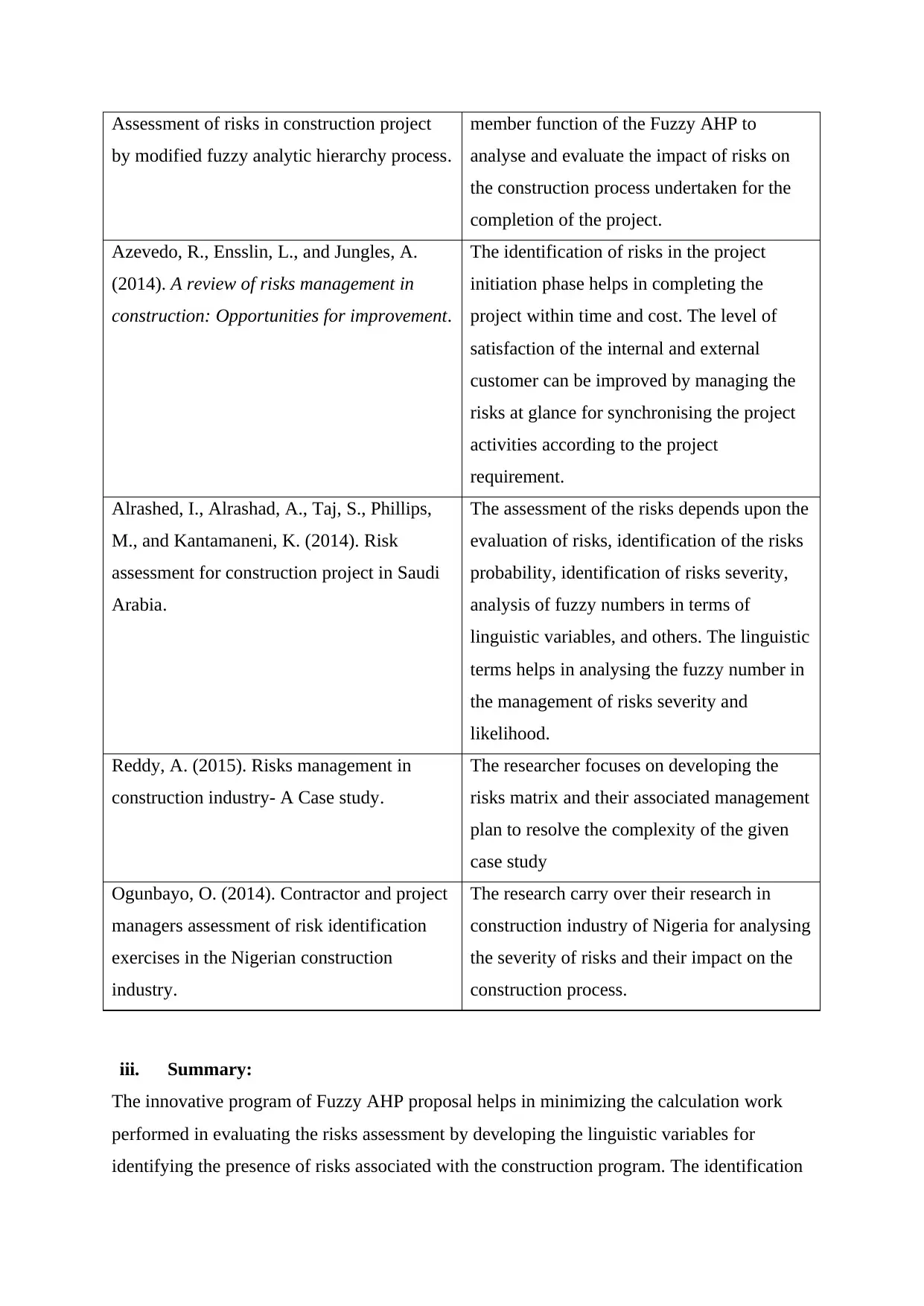
Assessment of risks in construction project
by modified fuzzy analytic hierarchy process.
member function of the Fuzzy AHP to
analyse and evaluate the impact of risks on
the construction process undertaken for the
completion of the project.
Azevedo, R., Ensslin, L., and Jungles, A.
(2014). A review of risks management in
construction: Opportunities for improvement.
The identification of risks in the project
initiation phase helps in completing the
project within time and cost. The level of
satisfaction of the internal and external
customer can be improved by managing the
risks at glance for synchronising the project
activities according to the project
requirement.
Alrashed, I., Alrashad, A., Taj, S., Phillips,
M., and Kantamaneni, K. (2014). Risk
assessment for construction project in Saudi
Arabia.
The assessment of the risks depends upon the
evaluation of risks, identification of the risks
probability, identification of risks severity,
analysis of fuzzy numbers in terms of
linguistic variables, and others. The linguistic
terms helps in analysing the fuzzy number in
the management of risks severity and
likelihood.
Reddy, A. (2015). Risks management in
construction industry- A Case study.
The researcher focuses on developing the
risks matrix and their associated management
plan to resolve the complexity of the given
case study
Ogunbayo, O. (2014). Contractor and project
managers assessment of risk identification
exercises in the Nigerian construction
industry.
The research carry over their research in
construction industry of Nigeria for analysing
the severity of risks and their impact on the
construction process.
iii. Summary:
The innovative program of Fuzzy AHP proposal helps in minimizing the calculation work
performed in evaluating the risks assessment by developing the linguistic variables for
identifying the presence of risks associated with the construction program. The identification
by modified fuzzy analytic hierarchy process.
member function of the Fuzzy AHP to
analyse and evaluate the impact of risks on
the construction process undertaken for the
completion of the project.
Azevedo, R., Ensslin, L., and Jungles, A.
(2014). A review of risks management in
construction: Opportunities for improvement.
The identification of risks in the project
initiation phase helps in completing the
project within time and cost. The level of
satisfaction of the internal and external
customer can be improved by managing the
risks at glance for synchronising the project
activities according to the project
requirement.
Alrashed, I., Alrashad, A., Taj, S., Phillips,
M., and Kantamaneni, K. (2014). Risk
assessment for construction project in Saudi
Arabia.
The assessment of the risks depends upon the
evaluation of risks, identification of the risks
probability, identification of risks severity,
analysis of fuzzy numbers in terms of
linguistic variables, and others. The linguistic
terms helps in analysing the fuzzy number in
the management of risks severity and
likelihood.
Reddy, A. (2015). Risks management in
construction industry- A Case study.
The researcher focuses on developing the
risks matrix and their associated management
plan to resolve the complexity of the given
case study
Ogunbayo, O. (2014). Contractor and project
managers assessment of risk identification
exercises in the Nigerian construction
industry.
The research carry over their research in
construction industry of Nigeria for analysing
the severity of risks and their impact on the
construction process.
iii. Summary:
The innovative program of Fuzzy AHP proposal helps in minimizing the calculation work
performed in evaluating the risks assessment by developing the linguistic variables for
identifying the presence of risks associated with the construction program. The identification
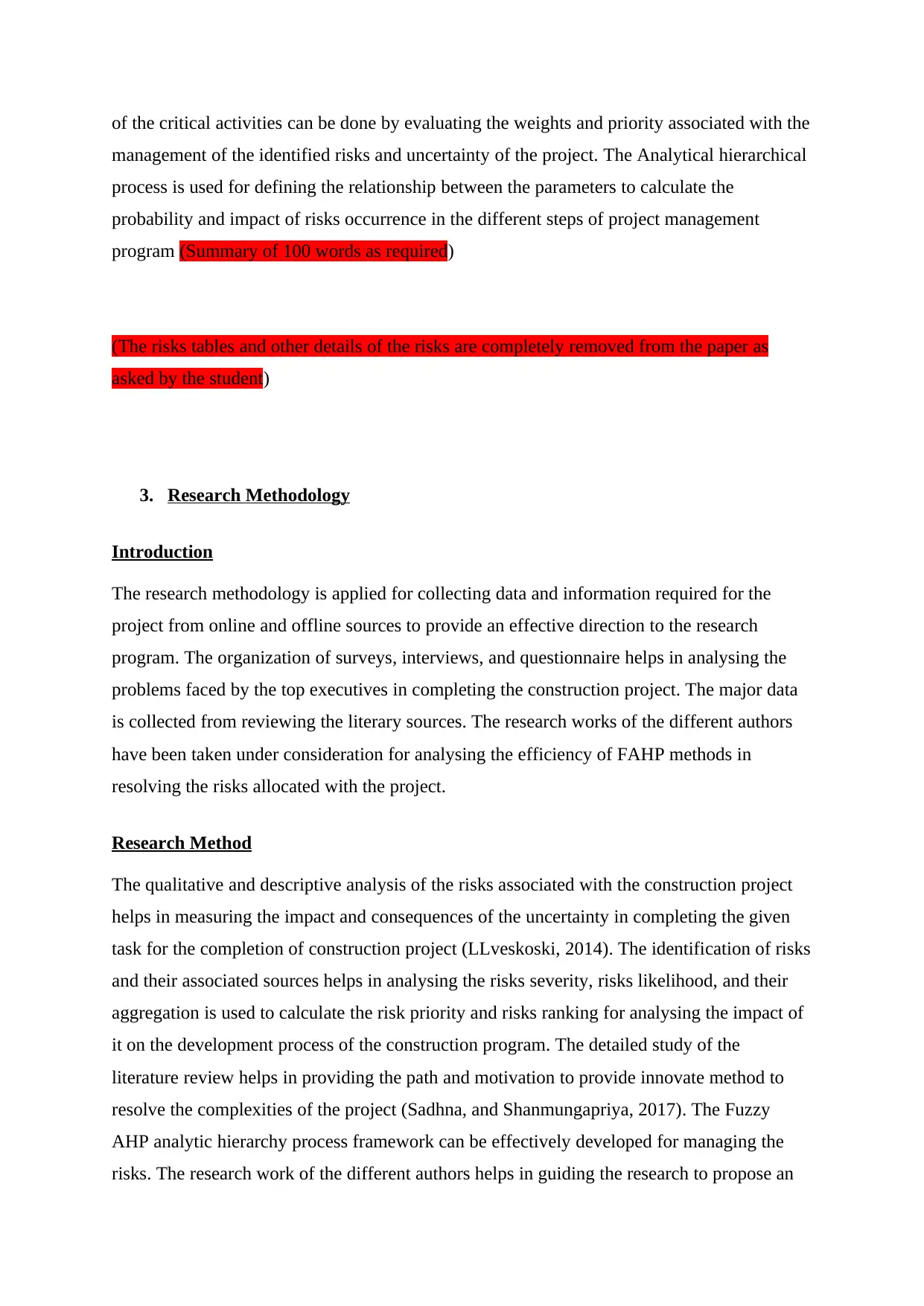
of the critical activities can be done by evaluating the weights and priority associated with the
management of the identified risks and uncertainty of the project. The Analytical hierarchical
process is used for defining the relationship between the parameters to calculate the
probability and impact of risks occurrence in the different steps of project management
program (Summary of 100 words as required)
(The risks tables and other details of the risks are completely removed from the paper as
asked by the student)
3. Research Methodology
Introduction
The research methodology is applied for collecting data and information required for the
project from online and offline sources to provide an effective direction to the research
program. The organization of surveys, interviews, and questionnaire helps in analysing the
problems faced by the top executives in completing the construction project. The major data
is collected from reviewing the literary sources. The research works of the different authors
have been taken under consideration for analysing the efficiency of FAHP methods in
resolving the risks allocated with the project.
Research Method
The qualitative and descriptive analysis of the risks associated with the construction project
helps in measuring the impact and consequences of the uncertainty in completing the given
task for the completion of construction project (LLveskoski, 2014). The identification of risks
and their associated sources helps in analysing the risks severity, risks likelihood, and their
aggregation is used to calculate the risk priority and risks ranking for analysing the impact of
it on the development process of the construction program. The detailed study of the
literature review helps in providing the path and motivation to provide innovate method to
resolve the complexities of the project (Sadhna, and Shanmungapriya, 2017). The Fuzzy
AHP analytic hierarchy process framework can be effectively developed for managing the
risks. The research work of the different authors helps in guiding the research to propose an
management of the identified risks and uncertainty of the project. The Analytical hierarchical
process is used for defining the relationship between the parameters to calculate the
probability and impact of risks occurrence in the different steps of project management
program (Summary of 100 words as required)
(The risks tables and other details of the risks are completely removed from the paper as
asked by the student)
3. Research Methodology
Introduction
The research methodology is applied for collecting data and information required for the
project from online and offline sources to provide an effective direction to the research
program. The organization of surveys, interviews, and questionnaire helps in analysing the
problems faced by the top executives in completing the construction project. The major data
is collected from reviewing the literary sources. The research works of the different authors
have been taken under consideration for analysing the efficiency of FAHP methods in
resolving the risks allocated with the project.
Research Method
The qualitative and descriptive analysis of the risks associated with the construction project
helps in measuring the impact and consequences of the uncertainty in completing the given
task for the completion of construction project (LLveskoski, 2014). The identification of risks
and their associated sources helps in analysing the risks severity, risks likelihood, and their
aggregation is used to calculate the risk priority and risks ranking for analysing the impact of
it on the development process of the construction program. The detailed study of the
literature review helps in providing the path and motivation to provide innovate method to
resolve the complexities of the project (Sadhna, and Shanmungapriya, 2017). The Fuzzy
AHP analytic hierarchy process framework can be effectively developed for managing the
risks. The research work of the different authors helps in guiding the research to propose an
⊘ This is a preview!⊘
Do you want full access?
Subscribe today to unlock all pages.

Trusted by 1+ million students worldwide
1 out of 28
Related Documents
Your All-in-One AI-Powered Toolkit for Academic Success.
+13062052269
info@desklib.com
Available 24*7 on WhatsApp / Email
![[object Object]](/_next/static/media/star-bottom.7253800d.svg)
Unlock your academic potential
Copyright © 2020–2025 A2Z Services. All Rights Reserved. Developed and managed by ZUCOL.




